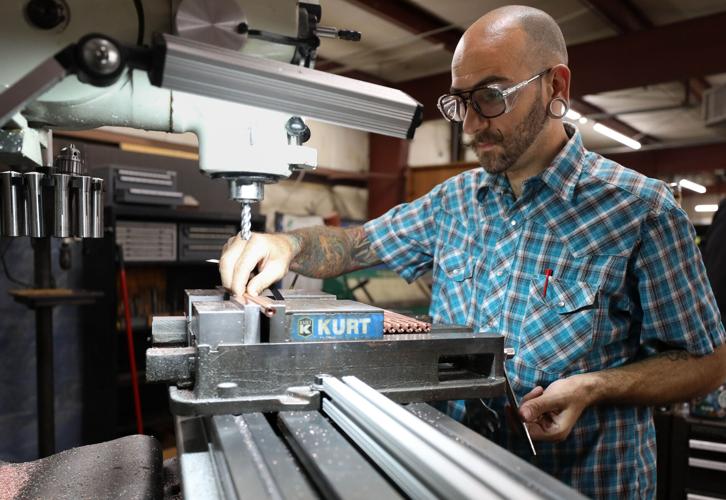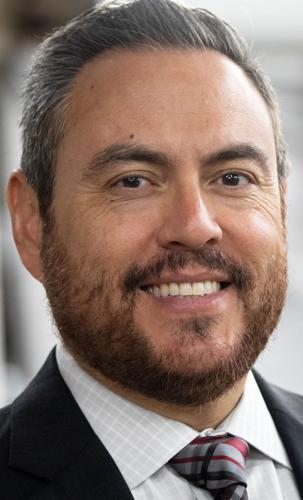One of Tucson’s oldest optics companies has a new name, a new chief executive and a focus on expanding markets for its infrared instruments beyond the stars.
Infrared Labs Inc. was founded in 1967 by pioneering University of Arizona scientist Frank J. Low to commercialize his invention of a highly sensitive instrument to measure infrared radiation — helping to open up a whole new field of astronomy and foster a generation of land- and space-based infrared telescopes.
The company, now known as IRLabs, would go on to become a key supplier of infrared detectors, known as bolometers, along with required cooling devices, for many of the world’s biggest infrared observatory projects.

Tyler Hummell, shop foreman at IRLabs, works on detector mount standoffs in the workshop, 1808 E. 17th St., in Tucson on Sept. 26.
In the mid-1990s, Infrared Labs turned its focus from stars millions of miles away to the microscopic world of semiconductor chips.
In 1996, Infrared Labs introduced the Infrared Emission Microscope (IREM) for the new application of failure analysis of semiconductors, using Low’s technologies for observing the faintest light emissions in deep space.
Low, who joined the UA’s Lunar and Planetary Laboratory in 1965 and retired after 30 years of research and teaching at the UA, died in 2009 at the age of 75.
Low’s legacy lives on at Infrared Labs, which has continued to supply its infrared detecting and cooling systems to observatories, national labs, defense research, private and university research and instrument and electronics companies worldwide, as well as for applications in semiconductors, medical devices, and other industries.
And the UA has remained a leader in the field, with major contributions to four major NASA infrared astronomy space telescopes, including most recently the James E. Webb Space Telescope — the most powerful space scope ever launched.
New energy
While the company has had continued success, the Low family owners of IRLabs last year hired a longtime local technology development expert and entrepreneur to reinvigorate the enterprise.
Manny Teran, a UA engineering alumnus with a background in technology development and startups, was named interim CEO of IRLabs in August 2022.

Teran
After leading several ventures and running the tech-development firm Aztera for nearly nine years, Teran joined the startup consultancy Spark Partners in 2020 and is currently CEO of the UA tech startup SaiOX, which is trying to commercialize a new helium-oxygen respiratory assist system.
But at IRLabs, Teran was tasked with focusing the long-established company on innovation with new technologies, markets and branding for its infrared detection and cryogenic products and services.
“I’m looking at, how do we take the company that’s been around for 55 years and ensure that it survives for another 55 years?” Teran said. “And the only way to do that is to grow, and to grow substantially. So we’re really spreading our wings in new markets that are adjacent. We’re not gonna go out and do something completely different, but we want to be smart about what we move into next.”
As part of efforts to raise its profile, Infrared Labs recently rebranded to use its longtime nickname, IRLabs, with the slogan “Innovating the infrared.”
IR innovation
Instruments to gather images and data in the infrared range — an invisible form of radiation between visible light and microwaves in the electromagnetic spectrum — are used by astronomers to peer deeper into space than possible with visible-light telescopes.
All four of the scientific instruments aboard NASA’s James Webb Space Telescope are designed for near- or mid-infrared wavelength analysis.
Low was involved in the development of many major infrared telescope projects, including the Infrared Astronomical Satellite, launched in 1983 as the first space telescope to gather infrared data, and NASA’s Spitzer Space Telescope, which was launched in 2003 and retired in 2020.
The company has continued to supply and innovate bolometers and cryogenic super-cooling equipment for ground and space IR telescopes, including making liquid-nitrogen cooling systems used to develop and test components of the Webb telescope.
In its longtime shop and office south of downtown in a nondescript industrial park on East 17th Street, the company and its staff of 16 designs and integrates custom infrared detecting systems and required super-cooling equipment.
Super-cooling sensors
A big part of IRLabs business is designing and building critical cooling systems for bolometers, since the devices are designed to operate optimally in temperatures near absolute zero, or nearly minus-500 degrees Fahrenheit.
IRLabs makes its own line of special vessels, called cryostats or dewars (after their inventor) to hold the cryogenic liquid nitrogen or liquid helium used to passively cool infrared detectors, as well as super-cooling, cryogen-free refrigeration systems.
IRLabs’ astronomy work in recent years has included designing a custom dewars for a European stratospheric balloon observatory project; a cryogenic refrigeration system for an infrared camera on the Gran Telescopio de Canarias in Spain’s Canary Islands; a retrofit of cooling equipment on NASA’s Mid-Infrared Spectrometer and Imager at Hawaii’s Mauna Kea Observatories; and a specialized cryostat for a near-infrared instrument installed on the Large Binocular Telescope on Mount Graham in eastern Arizona.
The company makes its own bolometers and integrates off-the-shelf optics to create custom infrared detecting systems, Teran said.

Bolometers, or infrared detectors, at IRLabs are cost effective, highly sensitive and offer cryogen-free options.
He said the company’s revenues, which have ranged from about $3 million to $5 million annually, rose 20% in the past year, progress Teran plans to continue with new products and markets.
Teran said the company plans to look into research and development grants to help propel the IRLabs’ product innovations.
Teran has instituted “new product days” where IRLabs’ staff gets together twice yearly to float their ideas for new products and services, with update meetings scheduled in the intervening quarters.
In the cooling area, IRLabs is nearing the rollout of an automated system to fill dewars with liquid nitrogen or helium — a task now typically done by hand, Teran said.
Spotting bad chips
Meanwhile, IRLabs continues to advance Low’s infrared microscopy technology for semiconductor analysis, which is used to spot failures on computer chips at the microscopic level, since anomalies can heat up and give off an infrared signal.
“When there’s a failure about to occur, when there are issues, it emits infrared light, so rather than have a telescope attached to it, you have a microscope,” Teran said.
IRLabs has launched its fourth version of its IREM system and soon plans to offer a new probe to automatically and repeatedly scan semiconductor chips, he added.
IRLabs’ engineering director, Chris Foster, came aboard after earning a degree in physics with an astronomy minor from the UA in 2000, just as the company rolled out its first IREM system.
Over the years, the company has incorporated the latest technology into each new version of the chip microscope, Foster said.
“They all use different size detectors and since then, they have gotten smaller and smaller, with better resolution and wavelength range,” he said. “So that (the technology) will travel around the world, because we have these all over the place.”
Teran said he sees opportunities for IRLabs as the U.S. seeks to onshore semiconductor manufacturing, citing investment driven by the federal CHIPS (Creating Helpful Incentives to Produce Semiconductors) and Science Act.
He also sees a future for IRLabs in quantum computing, which exploits atomic-level changes in the state of matter to achieve superior computational power compared with classical computing.
While practical and economical quantum computers are at least a decade away, Teran says the company could play a role because such computers now under development are based on superconducting circuits that have to be chilled to near absolute zero.
Loyal staff
Teran said the company has added a few employees in recent years, but most of the staff is comprised of longtime employees.
“The beauty of working for a company like IRLabs is we have such good people, and they don’t leave — our turnover is minuscule — and everybody works well together,” Teran said.
Foster said Teran’s arrival was “great energetically” for the company, and while he didn’t expect to hold the same job he got out of college some 23 years ago, he enjoys the work and his colleagues.
“It’s been a really good fit, I really enjoy what I do here,” said Foster. “It’s nice because we do a lot of prototypes, one-off, two-off systems, so it’s not like we we’re building the same thing every time.”






